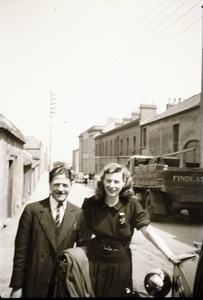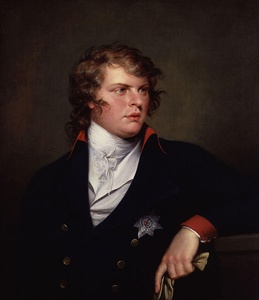 Sussex St in the 1950sSussex Street runs North-East from Lower George's St to Eblana Avenue. It joins to Lower George's St between Number 85 (formerly Findlaters, currently Penneys) and Number 86 (formerly Sir Thomas Browne's)
Sussex St in the 1950sSussex Street runs North-East from Lower George's St to Eblana Avenue. It joins to Lower George's St between Number 85 (formerly Findlaters, currently Penneys) and Number 86 (formerly Sir Thomas Browne's)
There is a small number of shops and a small number of commercial buildings.
The most prominent building on the street is the Boylan Community Centre Sussex St with buildings on the site(left) of the Boylan Centre
Sussex St with buildings on the site(left) of the Boylan Centre
History of the Street Name
 Augustus Frederick, Duke of Sussex (1773-1843)Sussex Street was previously known as Clock Lane, a reference to the clock on the turret of the Harbour Commissioners Office, which is exactly in line with the street.
Augustus Frederick, Duke of Sussex (1773-1843)Sussex Street was previously known as Clock Lane, a reference to the clock on the turret of the Harbour Commissioners Office, which is exactly in line with the street.
The name Sussex relates to the Augustus Frederick, Duke of Sussex (1773-1843), one of the 15 children of George III, and a brother to George IV. The names of his brothers, George IV and the dukes of Clarence, Cumberland, and York are also commemorated in streets and roads in Dún Laoghaire.
The 1860 map shows the name of Sussex Pl applied to both Sussex Street and Eblana Avenue, and Marine road as Sussex Parade. The 1870 map showed Sussex Street and Eblana Avenue in their modern layout.
In 2001, an attempt was made to rename the street to Sheridan Street in memory of Rev Bartholomew Sheridan (1799-1862) parish priest of Kingstown 1829-1862. The attempt failed. Sheridan lived at Eblana House, the last house on the west side of the street, near the junction with Eblana Avenue. The report below is reprinted from "Southside People"
|
SUSSEX STREET FACES A CHANGE OF NAME A proposal to change the name of Sussex Street in Dun Laoghaire to Sheridan Street is being supported by the Dun Laoghaire Community Association (DLCA) Michael Merrigan of the Irish Genealogical Society asked the last DLCA meeting to consider the change so that some memorial might be provided to Father Bartholomew Sheridan, PP of St Michael's (1829 to 1864), founder of many Catholic institutions in the town - including orphanages, schools and hospitals. Sussex Street, leading from Lr George's Street to Eblana Avenue, has few residents and contains the Parochial Hall (named after the late Monsignor Boylan) and the headquarters of the Glasthule Dun Laoghaire Credit Union. A change of name to 'Sheridan Street' under Section 192 of the Local Government Act, 2001, can only take place after residents (on the electoral list) are balloted. The proposal has been backed by the current Parish Priest, Father Patrick Mangan who, along with DLCA Chairman Christopher Wood, has written to the County Council asking it to conduct a ballot of residents. The niece of Canon Sheridan lived in Dun Laoghaire until recently when she died at the age of 103 years. |
"No memorial exists to the man who was the father of Catholic education in south County Dublin," says Michael Merrigan. "But if you look at the history of the institutions in the area - the Dominican Convent, St Michael's Hospital, St Joseph's Orphanage - his name keeps cropping up. It would be fitting to remember his work by naming a street after him. If the name change goes through Sheridan Street will be only the second street in the town to be named after an Irish person - Wellington Street was the first. To avoid confusion in the future it is suggested that signs read "Sheridan Street (formerly Sussex Street)." Father Bartholomew Sheridan was born in County Cavan in 1787 and entered Maynooth in 1809. He was ordained in 1814 and, in 1822, was appointed curate to Rev. Mr Doyle in Kingstown. On his death Fr Sheridan became the first parish priest of the newly-created Kingstown parish - a mini-diocese which ran from Kingstown to Little Bray. He built St Michael's Church in Dun Laoghaire, the Church of the Assumption, Dalkey, St Alphonsus, Killiney, St Brigid, Cabinteely, and the Church of St Peter, Bray. He had a keen interest in education and brought in various teaching orders. He died on May 12 1862 and is buried in St Michael's. From 'Southside People,' Dublin, 19 December 2001 |
|---|
History of the street
In her book on the life of Catherine MacAuley (foundress of the Sisters of Mercy), Mary C Sullivan describes how the nuns came into possession of a house on Sussex Place (now Sussex St) in 1835. The site was 74ft wide and 140 ft from front to back. She wished "to have a school for the poor girls whom we every day saw loitering about the roads in a neglected state". A builder, James Nugent was engaged in a rather informal fashion. Arguements which later developed between Nugent, the nuns, and Rev Bartholomew Sheridan were intense, with references to cheating and lying and high-handednmess being thrown around. Further research into this episode might be fruitful.
Businesses on the street
The 1850 maps show a market and weighing machine occupying part of the area now occupied by the Boylan Community Centre



